The x86 Power Myth Busted: In-Depth Clover Trail Power Analysis
by Anand Lal Shimpi on December 24, 2012 5:00 PM ESTPower During Boot
For the next test I measured power during a cold boot process. Here we're looking at power consumption from device off to hitting the Windows Start Screen:
Now we get our first glimpse of active power and there's a definite advantage here for Intel. Peak power consumption for the entire tablet tops out at just over 5W compared to 8W for Surface RT. Let's dig deeper to find what is responsible for the added power consumption:
The difference in average CPU power consumption is significant. Tegra 3 pulls around 1.29W on average compared to 0.48W for Atom. Atom also finishes the boot process quicker, which helps it get to sleep quicker and also contributes to improved power consumption.
GPU power is a big contributor as well with Tegra 3 averaging 0.80W and Atom pulling down 0.22W.
Launching Word 2013
As another simple test, I looked at power consumption while launching Microsoft Word 2013 on both platforms:
Here both tablets seemed to finish in about the same time but if you look at the power consumption graph you'll see that the W510 actually took a little bit longer. The difference wasn't great enough to really change the power profile: NVIDIA consumed 0.60W on average for its CPUs, while Intel pulled 0.48W on average:
Once again, there's a pretty stark difference on the GPU rail which makes me wonder if we're not looking at more than just GPU power here. Either that or Tegra 3's GPU implementation isn't all that power efficient compared to Imagination's. For the raw averages you're looking at 0.73W for NVIDIA compared to 0.23W for Intel.


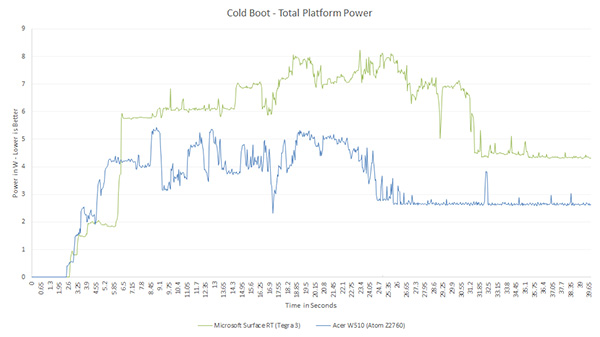
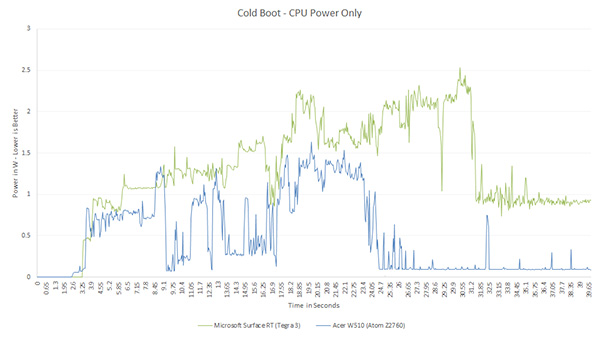
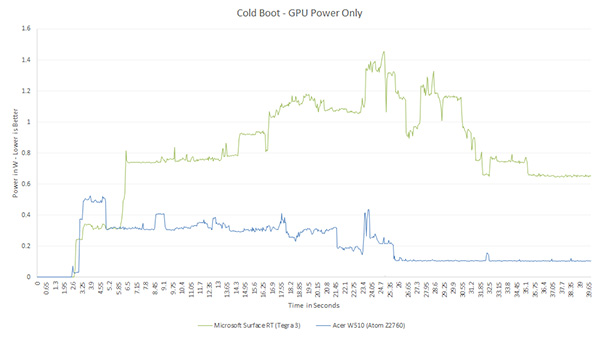
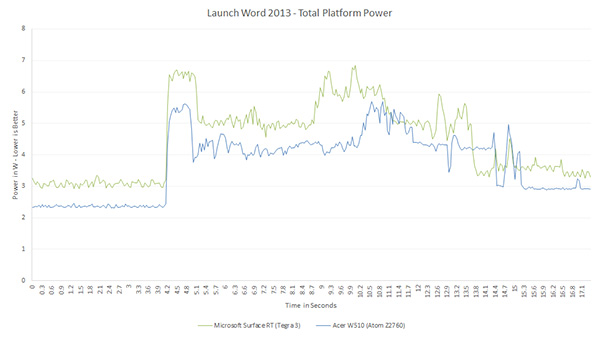
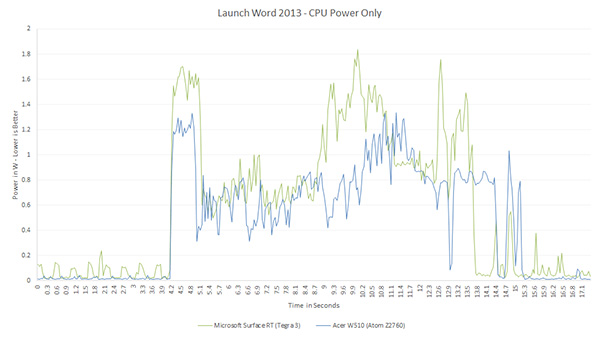
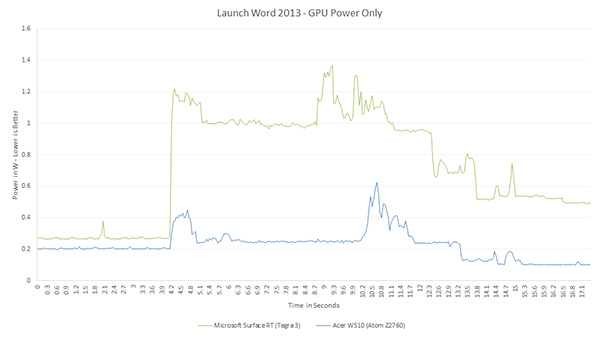








163 Comments
View All Comments
Exodite - Tuesday, December 25, 2012 - link
I think it's probably a fair guess that Apple has planned to converge their mobile and traditional computer business to the same hardware platform for some time.It's just not going to be x86.
wsw1982 - Tuesday, December 25, 2012 - link
However, the fact is the ATOM can emulate the ARM with similar performance, but not the other way around. It will be interesting to see apple fully commit to netbook level performance.StevoLincolnite - Tuesday, December 25, 2012 - link
Software compatibility isn't that big of a deal either as Intel showed us Binary Translation awhile ago allowing Medfield to run x86 and ARM instructions.krumme - Monday, December 24, 2012 - link
I think this just proves Intels business is not tailored for the new low cost mobile market. A9 on low cost 40nm eats Atom for breakfast each and every day on the market -fact- and A15 will do exactly the same on dirt cheap 28nm.tipoo - Monday, December 24, 2012 - link
I think we read different articles. Atom is rather competitive. It is not eaten for breakfast by 40nm ARM parts.yyrkoon - Tuesday, December 25, 2012 - link
depends on how you look at it. Find me an atom based 7" tablet for $200. Such as the Nexus 7 ( which many regard as the best tablet in its class )p3ngwin1 - Tuesday, December 25, 2012 - link
like i said in another comment here, you can get Chinese tablets running Android 4.1 with 1.6Ghz Dual-Core ARM processors with Mali400 GPU's (good enough for many) with 7" 1280x720 screens, etc all for less than $150.the chips are usually Allwinner or Rockchip, etc and the performance is good enough for most people at an incredible price that Intel simply can't match.
There's a reason in the early Netbook days why Intel wouldn't let Atom processors inside anything larger than 10" and 1024x768 screens, etc
It's because Intel didn't want people being happy with Atom performance in larger computers, so if you wanted larger screens, etc you were artificially forced to pay for more processing potential than you needed.
Intel have performance, and lately they're getting the power efficient too, but they are still a premium processor option and that's where ARM still has the advantage.
I don't see Intel willing to drop their prices any time soon to compete with cheap Android tablets. Intel would rather create bullcrap categories like "Ultra-book" (it's still a laptop for Christ-sake !) and convincing people they NEED expensive computers that cost $800+.
Meanwhile other ISA's like ARM and MIPS are lowering the price barrier to products with more than enough processing power and battery-life for most people.
Intel are left to convince people they need a desktop/laptop in a world increasingly going mobile and always-connected
yyrkoon - Tuesday, December 25, 2012 - link
You can even buy ICS tablets for as little as $50 is you keep an eye out.Personally though, I would not settle for anything less than the Nexus 7. Sometimes, peace of mind means more than money.
Point was however, that there is more than just power /watt efficiency to consider here. Especially when enjoying those number comes at a huge price premium.
Along the lines of what Intel can not match price wise. I am fairly confident that Intel can not even match prices with Texas Instruments in most cases. But I also believe that Intel does not need to convince buyers into thinking that desktops, and laptops are still necessary. Mainly because mostly they are( and will continue to be ). At minimum, high performance workstations, and servers will still need to exist for various applications.
I think that x86 and ARM both will continue to be around for a very long time. Which is a good thing.
wsw1982 - Tuesday, December 25, 2012 - link
So Intel cannot make atom cheaper because it don't need to pay TSMC for manufacture, don't need to pay ARM for license,do have mature 32 process than rest of the industry, do have the medfield's die area smaller than both tegra 3 and krait, and do have enough production capabilities idle for nothing.Desktop and server along could make Intel maintain manufacture advantage and R&D spending, how hurt is it to adopting the wasted production capability in produce the mobile chips as bonus? Anyway, the PC market will be still growing according to the all the prediction professionals, and the ATOM is quite safe to reuse the R&D spent on the core processors.
With 100$ you can also got the netbook from Chinese manufactures which, despite the cheap feeling and bad building quality, is as responsive and useful as the netbooks from big companies. But the 80$ android tablet is nearly unusable.
talzara - Thursday, December 27, 2012 - link
You do realize that Texas Instruments has exited the ARM processor business for mobile devices, right? The margins were too thin. They're still making ARMs for embedded devices, but they've given up on mobile.ARM is the classic disruptive innovation. It reduces prices for consumers, and cuts a swathe of destruction through industry margins. There are just too many players in ARM -- they're interchangeable enough that they have a hard time charging any kind of premium for their products.
Nvidia has shipped tens of millions of Tegras, so much so that it now accounts for 20% of Nvidia's revenues. Great business, right? Think again. Tegra accounts for -16% of Nvidia's net income. That's not a typo -- it really is a negative number. Nvidia makes all of its money from GPUs -- gaming GPUs, consumer GPUs, and GPUs sold for massively-parallel computing. (Source: Nvidia 10-Q for Q3 of fiscal 2013 -- segment breakdown at the bottom of page 27.)
So now we've got one major ARM vendor quitting, and another major ARM vendor bleeding cash. The ones that are doing well are the ones that don't actually care about the CPU. Qualcomm is horizontally integrated -- they make money on the LTE chipset. Apple and Samsung are vertically integrated -- they make their money on the whole device, not on the CPU.
In such a crazy market, Intel may well prefer to sell a premium product to 5% of the market, rather than a price-competitive product to 30%.